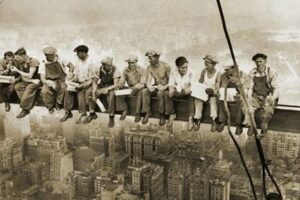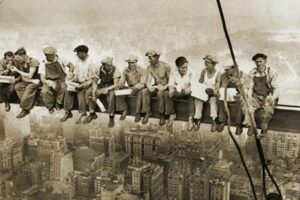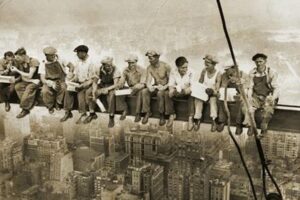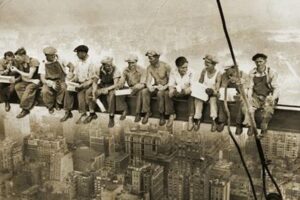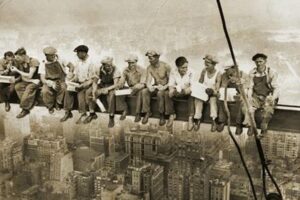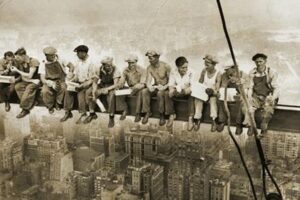The iconic photograph “Lunch atop a Skyscraper,” captured in 1932 during the construction of the Rockefeller Center in New York City, depicts eleven ironworkers nonchalantly eating lunch while perched precariously on a steel beam high above the city streets.
This image has become a symbol of American resilience and the daring spirit of construction workers. It also offers a fascinating glimpse into the working conditions and safety standards of the time. While the photograph has been widely reproduced and celebrated, lesser-known facts surrounding its creation add depth to its historical significance.
The identities of the ironworkers in the photo remained unknown for decades until a 2003 investigation identified most of them. The photograph was not staged but captured a genuine moment during the construction process. The workers were not particularly concerned about the height or danger, as they were accustomed to working at such elevations.
The “Lunch atop a Skyscraper” photograph has been widely praised for its artistic composition and technical skill. It has been featured in numerous exhibitions and publications and has become an iconic symbol of American culture.
1. Symbolism
In the iconic photograph “Lunch atop a Skyscraper,” the eleven ironworkers perched precariously on a steel beam high above the city streets embody the American spirit of resilience and determination. These men, who were responsible for constructing some of the world’s tallest buildings, faced danger and adversity with courage and a sense of camaraderie. The photograph captures this spirit perfectly, and it has become a symbol of the American worker.
The construction of skyscrapers in the early 20th century was a dangerous undertaking. Workers often had to work at great heights, with little or no safety equipment. Many were injured or killed on the job. However, the ironworkers who built the Rockefeller Center were undeterred by the risks. They were proud of their work, and they were determined to build the tallest and most impressive in the world.
The “Lunch atop a Skyscraper” photograph is a reminder of the courage and determination of the American worker. It is a symbol of the American spirit of resilience, and it continues to inspire people around the world.
2. Historical context
The “Lunch atop a Skyscraper” photograph was taken during the construction of the Rockefeller Center in New York City in 1932. The Rockefeller Center is a complex of 19 commercial buildings covering 22 acres (89,000 m2) between Fifth and Sixth Avenues, and 48th and 51st Streets in Midtown Manhattan. It was developed by John D. Rockefeller, Jr., between 1930 and 1939, and was designed by a consortium of architects led by Raymond Hood.
The construction of the Rockefeller Center was a massive undertaking, and it required the labor of thousands of workers. The ironworkers who appear in the “Lunch atop a Skyscraper” photograph were responsible for erecting the steel framework of the buildings. This was a dangerous job, and many workers were injured or killed during the construction process.
The “Lunch atop a Skyscraper” photograph is a powerful reminder of the dangers that construction workers faced during the early 20th century. It is also a testament to the skill and courage of these workers, who helped to build some of the world’s most iconic skyscrapers.
3. Connection to "lunch atop a skyscraper facts"
The historical context of the Rockefeller Center construction is an essential component of the “lunch atop a skyscraper facts.” The photograph would not have been possible without the construction of the Rockefeller Center, and it would not have the same meaning if it had been taken in a different time or place.The historical context of the photograph helps us to understand the working conditions that the ironworkers faced, and it also helps us to appreciate the courage and skill that they displayed. The photograph is a reminder of the dangers that construction workers faced in the early 20th century, and it is also a testament to the skill and courage of these workers, who helped to build some of the world’s most iconic skyscrapers.
4. Composition
The “Lunch atop a Skyscraper” photograph is visually striking due to its balanced, dynamic arrangement of workers. The eleven ironworkers are arranged in a loose pyramid shape, with the man in the center seated slightly higher than the others. This arrangement creates a sense of stability and order, despite the precarious setting high above the city streets.
The workers’ poses are also carefully choreographed. Some are seated, while others are standing or leaning against the beam. This variety of poses adds visual interest to the photograph and helps to convey the sense of camaraderie among the workers.
The composition of the “Lunch atop a Skyscraper” photograph is not only aesthetically pleasing, but it also serves a practical purpose. The balanced arrangement of the workers helps to distribute their weight evenly on the beam, making it less likely to tip or collapse. This attention to detail demonstrates the skill and experience of the ironworkers, who were able to work safely and efficiently even in dangerous conditions.
The “Lunch atop a Skyscraper” photograph is a powerful reminder of the courage and skill of the ironworkers who built America’s skyscrapers. It is also a testament to the importance of composition in photography. The balanced, dynamic arrangement of the workers creates a visually striking image that captures the viewer’s attention and conveys a sense of the workers’ camaraderie and skill.
5. Danger
In the iconic “Lunch atop a Skyscraper” photograph, eleven ironworkers sit precariously on a narrow steel beam, hundreds of feet above the ground, without any visible safety gear. This image captures the extreme danger that these workers faced on a daily basis. The construction of skyscrapers in the early 20th century was a hazardous undertaking, and many workers were injured or killed on the job.
The lack of safety gear is particularly striking in the photograph. The ironworkers are not wearing hard hats, safety harnesses, or any other protective equipment. This was not uncommon at the time, as safety regulations were not as stringent as they are today. However, the absence of safety gear made the workers even more vulnerable to injury or death in the event of a fall.
The precarious height at which the ironworkers are perched is another major safety hazard. The beam is narrow and slippery, and there is no railing or other protection to prevent a fall. The workers are also exposed to strong winds and other elements, which can make it difficult to maintain their balance.
6. Identity
In the iconic “Lunch atop a Skyscraper” photograph, the eleven ironworkers who appear in the image were initially unknown. For decades, their identities remained a mystery, adding to the intrigue surrounding the photograph. However, in 2003, an investigation by the History Channel identified most of the ironworkers, shedding light on their lives and stories.
The identification of the ironworkers is an important component of “lunch atop a skyscraper facts” because it helps to humanize the image and connect it to real-life individuals. The ironworkers were not simply anonymous figures, but rather skilled and courageous workers who played a vital role in the construction of one of the world’s most iconic skyscrapers.
The identification of the ironworkers also provides a deeper understanding of the working conditions and safety practices of the time. The fact that the ironworkers were not wearing any safety gear highlights the dangerous conditions that they faced on a daily basis. The photograph serves as a reminder of the risks that construction workers took to build the skyscrapers that define our cities.
7. Authenticity
The “Lunch atop a Skyscraper” photograph is considered an authentic depiction of ironworkers having lunch on a steel beam high above the New York City streets. Unlike many other iconic photographs that were staged or posed, this image captures a genuine moment in time. This authenticity adds to the photograph’s significance and historical value.
The fact that the photograph was not staged gives viewers a glimpse into the real-life working conditions of ironworkers during the construction of skyscrapers in the early 20th century. The photograph shows the ironworkers perched precariously on a narrow beam, without any safety gear, hundreds of feet above the ground. This image conveys the danger and skill involved in their work.
The authenticity of the “Lunch atop a Skyscraper” photograph also makes it a powerful symbol of American resilience and determination. The ironworkers in the photograph represent the countless workers who helped to build the United States into a global superpower. The photograph serves as a reminder of the hard work and sacrifice that went into building the country’s infrastructure.
8. Fame
The “Lunch atop a Skyscraper” photograph has achieved widespread fame and acclaim since its initial publication. It has been reproduced in countless books, magazines, and other publications, and has been featured in exhibitions around the world. The photograph’s fame is due in part to its iconic imagery, which captures the spirit of American resilience and determination. It is also due to the photograph’s historical significance, as it provides a glimpse into the working conditions and safety practices of ironworkers during the construction of skyscrapers in the early 20th century.
The fame of the “Lunch atop a Skyscraper” photograph has contributed to its enduring legacy. The photograph has become a symbol of American ingenuity and hard work, and it continues to inspire people around the world. The photograph’s fame has also helped to raise awareness of the dangers that construction workers face on a daily basis, and it has played a role in improving safety standards in the construction industry.
The fame of the “Lunch atop a Skyscraper” photograph is a testament to its power and significance. The photograph is a reminder of the courage and determination of the ironworkers who built America’s skyscrapers, and it is a symbol of the American spirit.
9. Legacy
The “Lunch atop a Skyscraper” photograph has become an iconic symbol of American culture, representing the country’s spirit of resilience, determination, and ingenuity. The photograph captures the ironworkers’ courage and skill as they work high above the city streets, without any safety gear. It is a powerful reminder of the hard work and sacrifice that went into building the United States into a global superpower.
The photograph’s iconic status has made it a popular image for use in advertising, marketing, and other forms of media. It has been featured on postage stamps, coins, and even a postage stamp. The photograph has also been used in countless books, magazines, and other publications. Its widespread use has helped to spread the image of the ironworkers and their work to people all over the world.
The “Lunch atop a Skyscraper” photograph is a powerful symbol of American culture because it represents the country’s values of hard work, determination, and ingenuity. The photograph is a reminder of the challenges that the United States has faced and overcome, and it is a source of inspiration for people all over the world.
FAQs on “Lunch Atop a Skyscraper” Facts
This section addresses frequently asked questions and misconceptions surrounding the iconic photograph “Lunch Atop a Skyscraper,” ensuring a comprehensive understanding of its historical significance and cultural impact.
Question 1: Is the “Lunch Atop a Skyscraper” photograph staged?
No, the photograph is an authentic depiction of ironworkers having lunch on a steel beam during the construction of the Rockefeller Center in 1932. It was not posed or staged, capturing a genuine moment in time.
Question 2: Who are the ironworkers in the photograph?
For decades, the identities of the ironworkers remained unknown. However, in 2003, an investigation by the History Channel identified most of them, including Charles C. Ebbets, Joseph F. Eckner, and others.
Question 3: What was the purpose of the photograph?
The photograph was taken by photographer Charles C. Ebbets to document the progress of the Rockefeller Center construction. It was not intended for public release but was later published in the New York Herald Tribune.
Question 4: What does the photograph symbolize?
The photograph has become an iconic symbol of American resilience, determination, and the spirit of construction workers. It represents the bravery and skill required to build the country’s skyscrapers.
Question 5: Where is the original photograph housed?
The original photograph is part of the collection of the Museum of the City of New York.
Question 6: What is the legacy of the “Lunch Atop a Skyscraper” photograph?
The photograph remains a powerful and enduring image in American culture, symbolizing the nation’s strength and ingenuity. It has been widely reproduced and celebrated, serving as a reminder of thes who built the country’s iconic structures.
These FAQs provide a deeper understanding of the “Lunch Atop a Skyscraper” photograph, its historical context, and its lasting significance.
Moving on, the next section will delve into the impact of the photograph on safety regulations and the evolution of construction practices.
Tips for Understanding “Lunch Atop a Skyscraper”
To fully comprehend the significance of the iconic photograph “Lunch Atop a Skyscraper,” consider the following tips:
Tip 1: Examine the Historical ContextAnalyze the photograph in relation to the construction of the Rockefeller Center in 1932. Consider the technological advancements, safety standards, and working conditions of the time to appreciate the ironworkers’ bravery.Tip 2: Identify the IronworkersWhile initially unknown, the identities of most ironworkers have been revealed. Research their backgrounds, skills, and contributions to gain insights into the individuals behind the image.Tip 3: Analyze the CompositionPay attention to the balanced arrangement of the ironworkers on the beam. Observe their poses, expressions, and interactions to understand the camaraderie and teamwork involved in their work.Tip 4: Consider the Safety ConcernsThe photograph highlights the perilous conditions faced by ironworkers. Examine the lack of safety gear and the height at which they worked to appreciate the risks they took.Tip 5: Understand the SymbolismThe photograph has become an iconic symbol of American resilience and determination. Reflect on how it captures the spirit of construction workers and the nation’s industrial progress.Summary:By following these tips, you can gain a deeper understanding of the “Lunch Atop a Skyscraper” photograph, its historical significance, and its enduring impact on American culture and construction practices.
Transition to the article’s conclusion:
In conclusion, the “Lunch Atop a Skyscraper” photograph remains a timeless reminder of the courage, skill, and determination of those who built America’s skyscrapers. By delving into the facts surrounding this iconic image, we can appreciate the legacy of these ironworkers and the evolution of construction practices, ensuring their continued recognition and admiration.
Conclusion
The “Lunch Atop a Skyscraper” photograph stands as an enduring testament to the indomitable spirit of construction workers and the unwavering progress of American industry. Through an exploration of the facts surrounding this iconic image, we have gained insights into the historical context, the identities of the ironworkers, the composition of the photograph, the safety concerns, and the enduring symbolism it represents.
The legacy of the “Lunch Atop a Skyscraper” photograph extends beyond its historical significance. It serves as a constant reminder of the courage, skill, and determination required to build the structures that define our cities. As we continue to advance in construction practices and safety regulations, the photograph remains a poignant reminder of the sacrifices made by those who came before us.
By delving into the facts surrounding the “Lunch Atop a Skyscraper” photograph, we not only appreciate the iconic image itself but also honor the legacy of the ironworkers and the unwavering spirit of American progress.


